Visualized Multiprobe Electrical Impedance Measurements with STM Tips Using Shear Force Feedback Control
Abstract
:1. Introduction
2. Shear Force Control on Metallic Sharp Probes
3. Multiprobe Experimental Setup
4. Results and Discussion
4.1. Calibration Experiments
4.2. Microparticle Impedance Measurement
5. Conclusions
Acknowledgments
Author Contributions
Conflicts of Interest
References
- Binning, G.; Rohrer, H. Scanning tunneling microscopy. IBM J. Res. 1986, 30, 40–54. [Google Scholar]
- Mathwig, K.; Aartsma, T.; Canters, G.; Lemay, S. Nanoscale Methods for Single-Molecule Electrochemistry. Ann. Rev. Anal. Chem. 2014, 7, 383–404. [Google Scholar] [CrossRef] [PubMed]
- Raigoza, A.; Dugger, J.; Webb, L. Review: Recent Advances and Current Challenges in Scanning Probe Microscopy of Biomolecular Surfaces and Interfaces. ACS Appl. Mater. Interfaces 2014, 5, 9249–9261. [Google Scholar] [CrossRef] [PubMed]
- Binning, G.; Quate, C.; Gerber, C. Atomic Force Microscope. Phys. Rev. Lett. 1986, 56, 930–933. [Google Scholar] [CrossRef] [PubMed]
- Hofer, W.; Fisher, A. Signature of a Chemical Bonde in the Conductance between Two Metal Surfaces. Phys. Rev. Lett. 2003, 91, 036803. [Google Scholar] [CrossRef] [PubMed]
- Bowker, M.; Davies, P. Scanning Tunneling Microscopy in Surface Science, Nanoscience and Catalysis, 1st ed.; Wiley-VCH: Weinheim, Germany, 2010. [Google Scholar]
- Itaya, K.; Tomita, E. Scanning tunneling microscope for electrochemistry—A new concept for the in situ scanning tunneling microscope in electrolyte solutions. Surf. Sci. 1988, 3, L507–L512. [Google Scholar] [CrossRef]
- Bard, A.; Fan, K. Scanning Electrochemical Microscopy. An introduction and Principles. Anal. Chem. 1989, 61, 132–138. [Google Scholar] [CrossRef]
- Hansma, P.; Drake, B.; Marti, O.; Gould, S.; Prater, C. The scanning ion-conductance microscope. Science 1989, 243, 641–643. [Google Scholar] [CrossRef] [PubMed]
- Houze, F.; Meyer, R.; Schneegans, O.; Boyer, L. Imaging the local properties of metal surfaces by atomic force microscopy with conducting probes. Appl. Phys. Lett. 1996, 69, 1975–1977. [Google Scholar] [CrossRef]
- Nonnenmacher, M.; O’Boyle, M.; Wickramasinghe, H. Kelvin probe force microscopy. Appl. Phys. Lett. 1991, 58, 2921–2923. [Google Scholar] [CrossRef]
- Law, B.; Rieutord, F. Electrostatic forces in atomic forces microscopy. Phys. Rev. B 2002, 66, 035402. [Google Scholar] [CrossRef]
- Sawada, D.; Sugimoto, Y.; Morita, K.; Abe, M.; Morita, S. Simultaneous measurement of force and tunneling current at room temperature. Appl. Phys. Lett. 2009, 94, 173117. [Google Scholar] [CrossRef]
- Wei, Y.; Wu, C.; Wang, W. Shape Reconstruction Based on New Blurring Model at the Micro/Nanometer Scale. Sensors 2016, 16, 302. [Google Scholar] [CrossRef] [PubMed]
- Penner, R.; Heben, M.; Longin, T.; Lewis, N. Fabrication and Use of Nanometer-Sized Electrodes in Electrochemistry. Science 1990, 250, 1118–1121. [Google Scholar] [CrossRef] [PubMed]
- Guell, A.; Diez-Perez, I.; Gorostiza, P.; Sanz, F. Preparation of reliable probes for electrochemical tunneling spectroscopy. Anal. Chem. 2004, 76, 5218–5222. [Google Scholar] [CrossRef] [PubMed]
- Otero, J.; Gonzalez, L.; Puig-Vidal, M. Nanocharacterization of Soft Biological Samples in Shear Mode with Quartz Tuning Fork Probes. Sensors 2012, 12, 4803–4819. [Google Scholar] [CrossRef] [PubMed]
- Wu, Z.; Guo, T.; Tao, R.; Liu, L.; Chen, J.; Fu, X.; Hu, X. A Unique Self-Sensing, Self-Actuating AFM Probe at Higher Eigenmodes. Sensors 2015, 15, 28764–28771. [Google Scholar] [CrossRef] [PubMed]
- Gonzalez, L.; Oria, R.; Botaya, L.; Puig-Vidal, M.; Otero, J. Determination of the static spring constant of electrically-driven quartz tuning forks with two freely oscillating prongs. Nanotechnology 2015, 26, 055501. [Google Scholar] [CrossRef] [PubMed]
- Gonzalez, L.; Martinez-Martin, D.; Otero, J.; de Pablo, P.; Puig-Vidal, M.; Gomez-Herrero, J. Improving the Lateral Resolution of Quartz Tuning Fork-Based Sensors in Liquid by Integrating Commercial AFM Tips into the Fiber End. Sensors 2015, 15, 1601–1610. [Google Scholar] [CrossRef] [PubMed]
- Castellanos, A.; Agraït, N.; Rubio-Bollinger, G. Dynamics of quartz tuning fork sensor used in scanning probe microscopy. Nanotechnology 2009, 20, 215502. [Google Scholar] [CrossRef] [PubMed]
- Otero, J.; Gonzalez, L.; Cabezas, G.; Puig-Vidal, M. Multitool Platform for Morphology and Nanomechanical Characterization of Biological Samples with Coordinated Self-Sensing Probes. IEEE/ASME Trans. Mechatron. 2013, 18, 1152–1160. [Google Scholar] [CrossRef]
- Mühlschlegel, P.; Toquant, J.; Pohl, D.; Hecht, B. Glue-free tuning fork shear-force microscope. Rev. Sci. Instr. 2006, 77, 016105. [Google Scholar] [CrossRef]
- Botaya, L.; Otero, J.; Gonzalez, L.; Coromina, X.; Gomila, G.; Puig-Vidal, M. Quartz tuning fork-based conductive atomic force microscope with glue-free solid metallic tips. Sens. Actuators A Phys. 2015, 232, 259–266. [Google Scholar] [CrossRef]
- Gonzalez, L.; Otero, J.; Cabezas, G.; Puig-Vidal, M. Electronic Driver with Amplitude and Quality Factor Control to Adjust the Response of Quartz Tuning fork Sensors in Atomic Force Microscopy Applications. Sens. Actuator A Phys. 2012, 184, 112–118. [Google Scholar] [CrossRef]
- Fumagalli, L.; Ferrari, G.; Sampietro, M.; Gomila, G. Quantitative nanoscale dielectric constant measurement of thin films by DC electrostatic force microscopy. Nano Lett. 2009, 98, 1604–1608. [Google Scholar] [CrossRef] [PubMed]
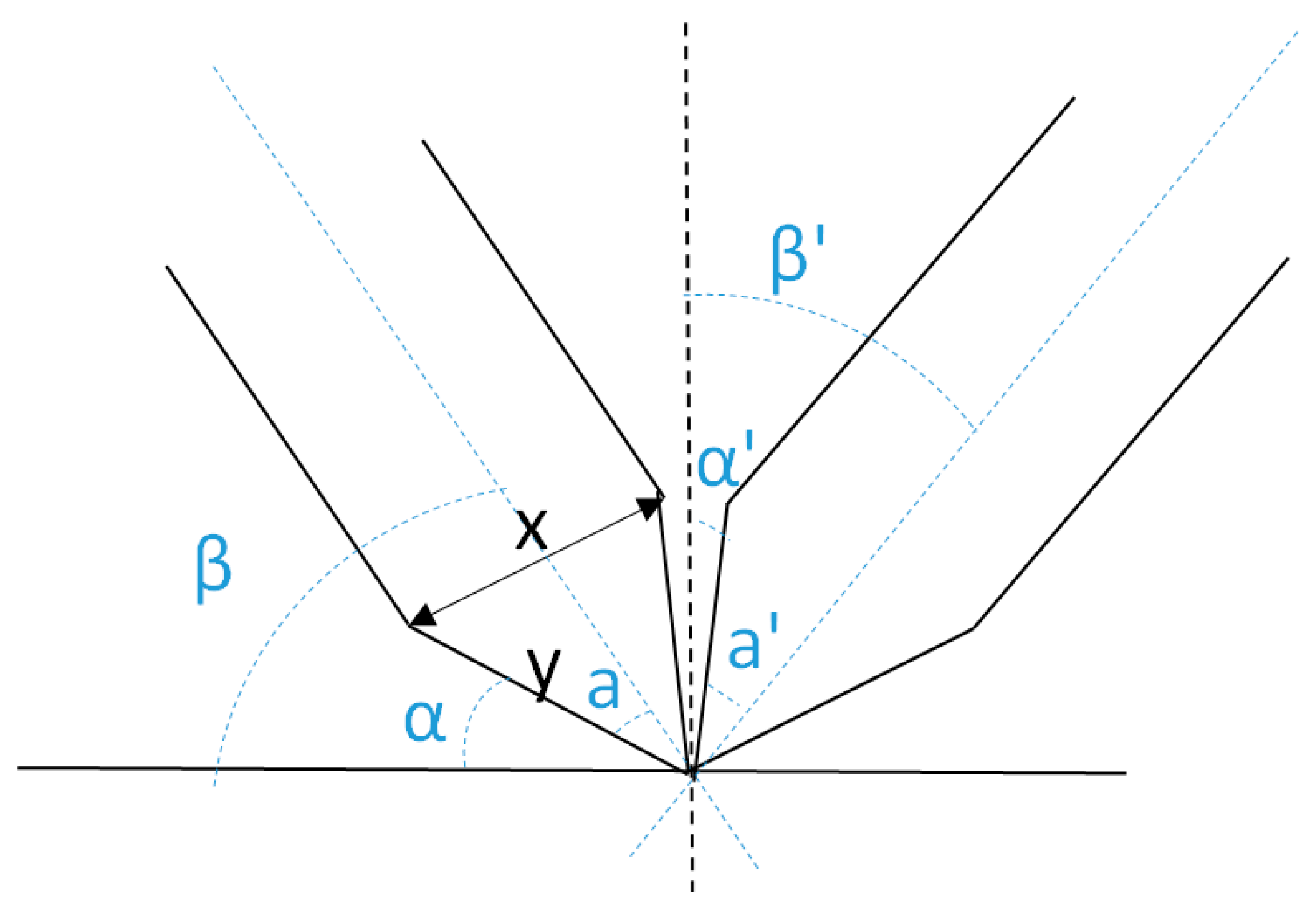

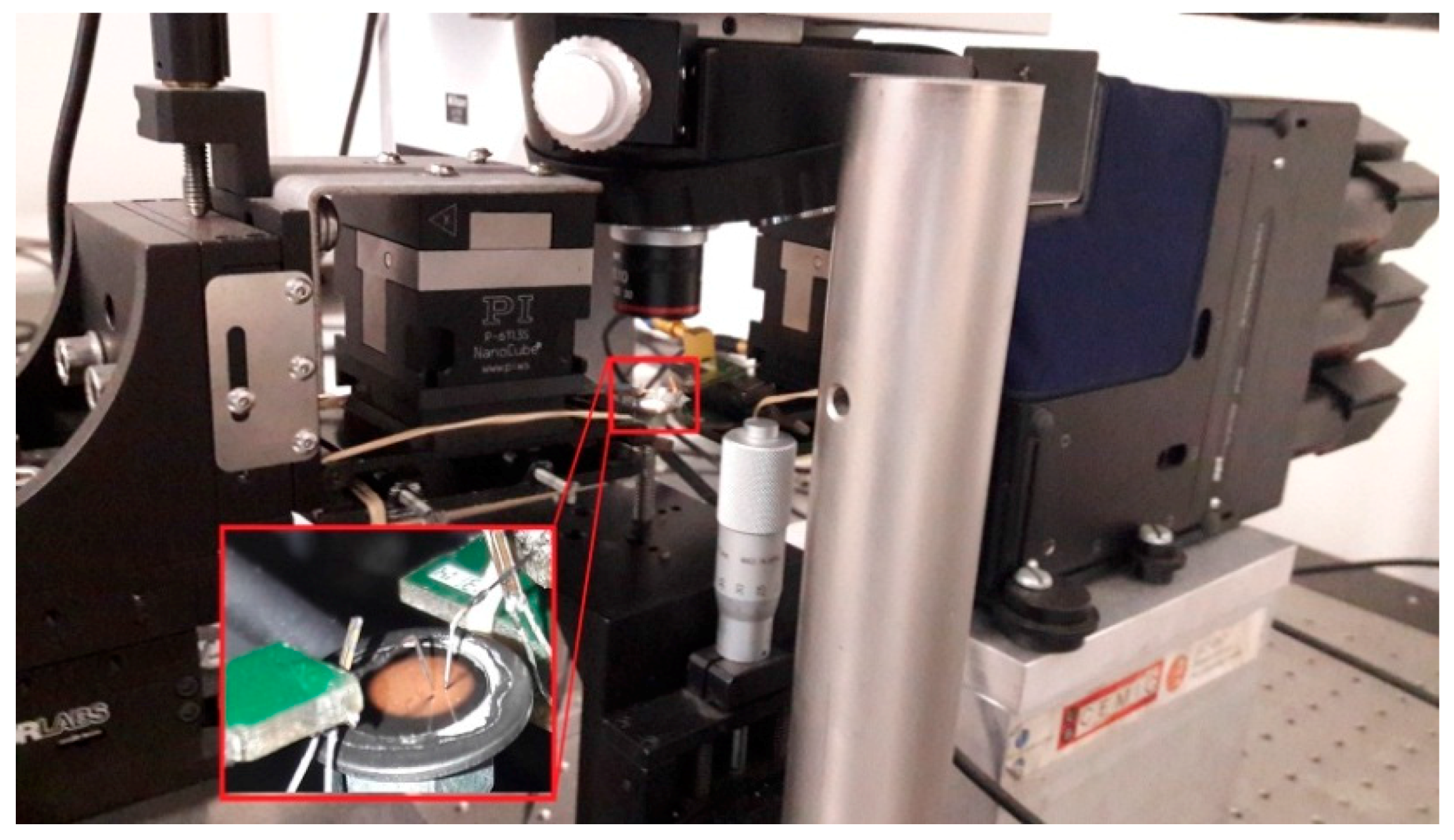

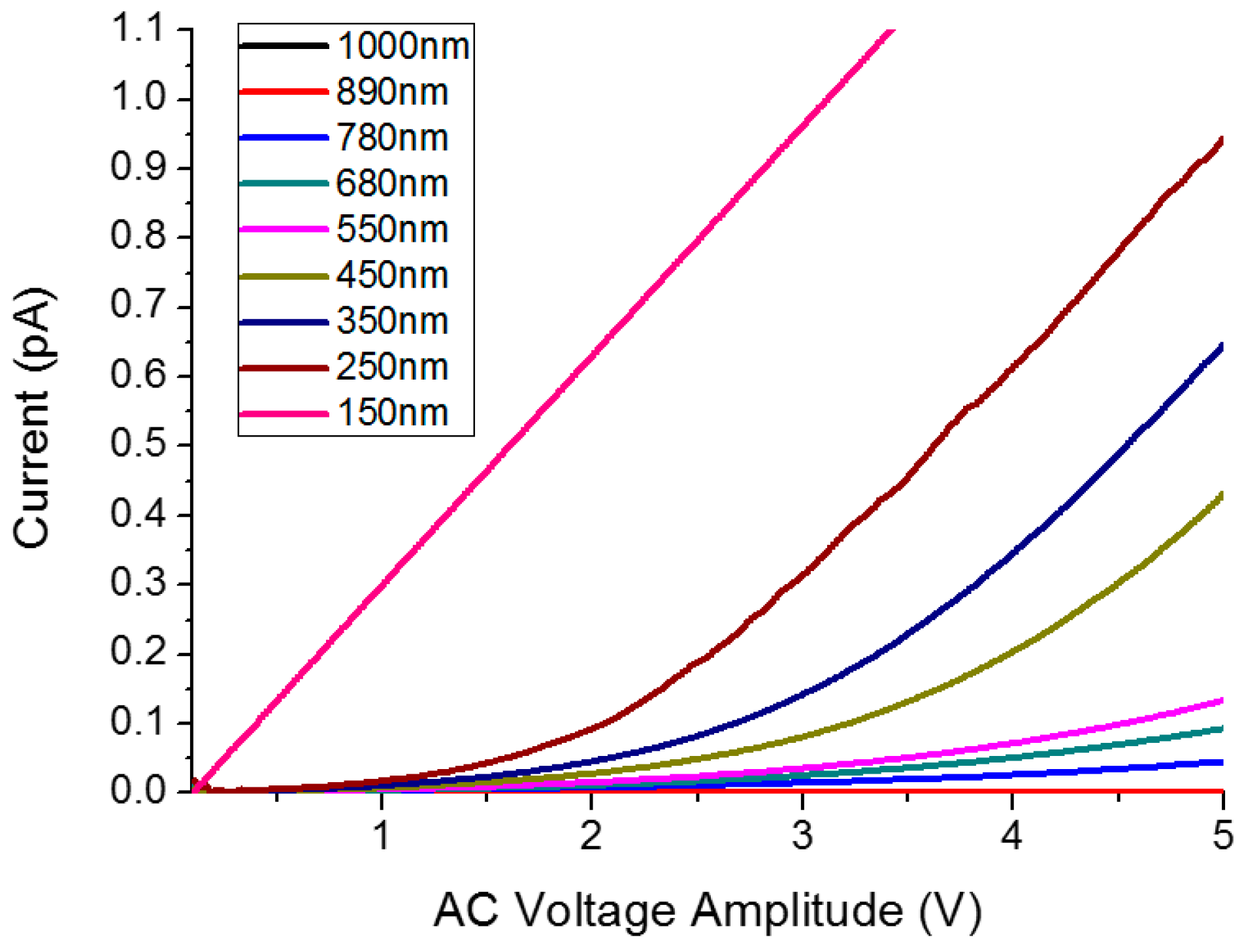
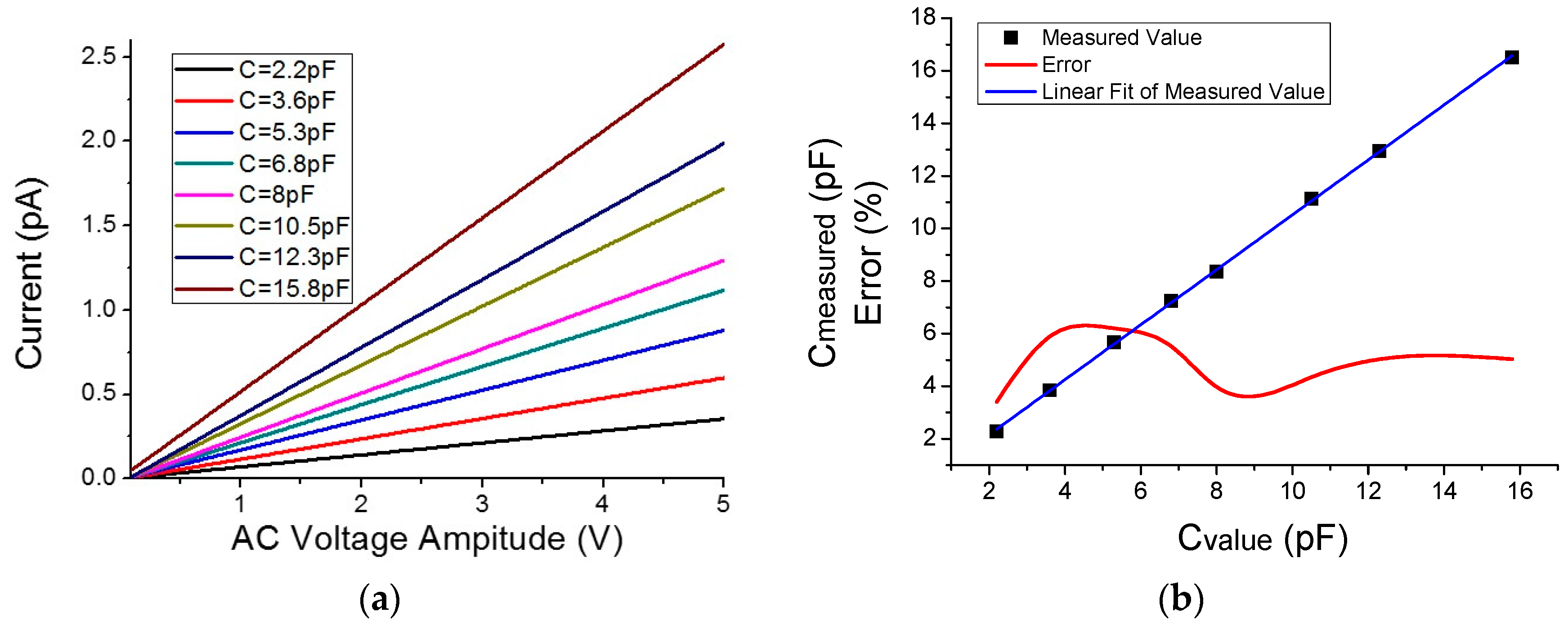

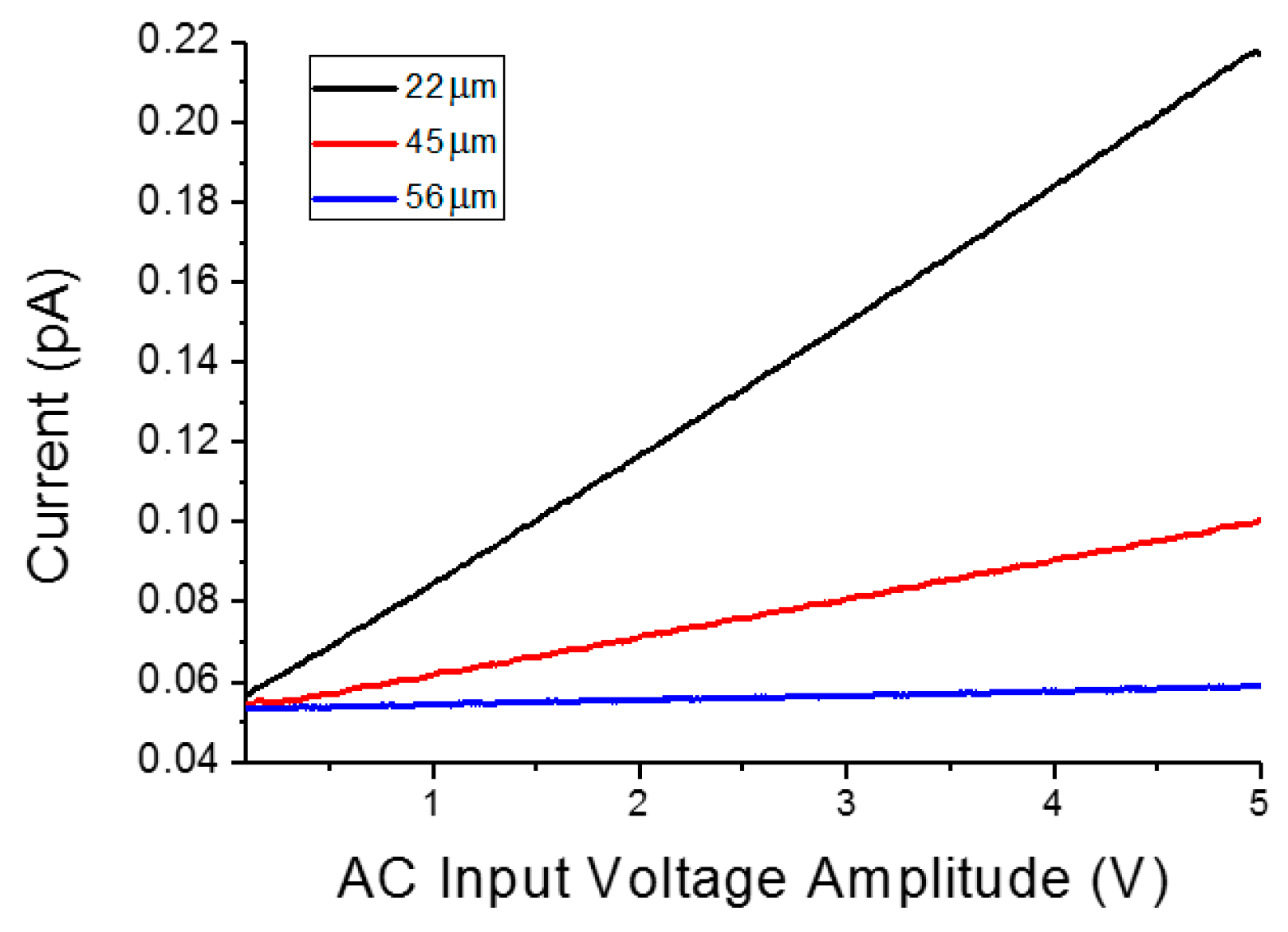
© 2016 by the authors; licensee MDPI, Basel, Switzerland. This article is an open access article distributed under the terms and conditions of the Creative Commons Attribution (CC-BY) license (http://creativecommons.org/licenses/by/4.0/).
Share and Cite
Botaya, L.; Coromina, X.; Samitier, J.; Puig-Vidal, M.; Otero, J. Visualized Multiprobe Electrical Impedance Measurements with STM Tips Using Shear Force Feedback Control. Sensors 2016, 16, 757. https://doi.org/10.3390/s16060757
Botaya L, Coromina X, Samitier J, Puig-Vidal M, Otero J. Visualized Multiprobe Electrical Impedance Measurements with STM Tips Using Shear Force Feedback Control. Sensors. 2016; 16(6):757. https://doi.org/10.3390/s16060757
Chicago/Turabian StyleBotaya, Luis, Xavier Coromina, Josep Samitier, Manel Puig-Vidal, and Jorge Otero. 2016. "Visualized Multiprobe Electrical Impedance Measurements with STM Tips Using Shear Force Feedback Control" Sensors 16, no. 6: 757. https://doi.org/10.3390/s16060757
APA StyleBotaya, L., Coromina, X., Samitier, J., Puig-Vidal, M., & Otero, J. (2016). Visualized Multiprobe Electrical Impedance Measurements with STM Tips Using Shear Force Feedback Control. Sensors, 16(6), 757. https://doi.org/10.3390/s16060757





